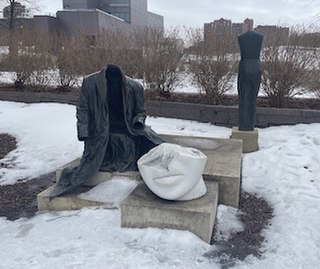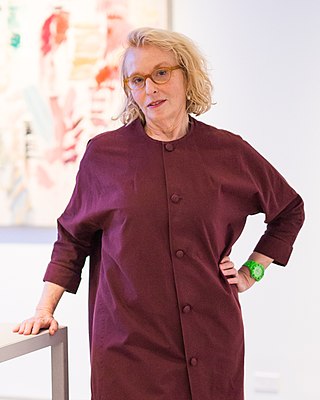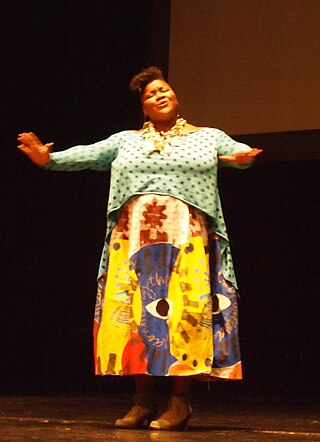
Hannah Wilke (born Arlene Hannah Butter; was an American painter, sculptor, photographer, video artist and performance artist. Her work is known for exploring issues of feminism, sexuality and femininity.

Judith Shea is an American sculptor and artist, born in Philadelphia, Pennsylvania, in 1948. She was awarded a degree in fashion design from the Parsons School of Design in 1969 and earned her Bachelor of Fine Arts degree there in 1975. This dual education formed the basis for her figure based works.
Nancy Grossman is an American artist. Grossman is best known for her wood and leather sculptures of heads.

Cleo Hartwig was an American sculptor who worked in stone, wood, terra cotta, plaster, paper, woodcut, and ceramic. She won a number of awards, including national awards, and her work is exhibited across the northeast U.S. She is regarded as a member of The New York School.

Martine Fougeron is a French-American photographer and film maker based in Paris and New York City. Her work has been exhibited and published extensively, and collected by numerous major museums including the Museum of Fine Arts, Houston, Philadelphia Museum of Art, and the Bronx Museum of the Arts. Fougeron has published one monograph to date: Nicolas et Adrien – A World with Two Sons, published by Steidl in 2019.
Elaine Lustig Cohen was an American graphic designer, artist and archivist. She is best known for her work as a graphic designer during the 1950s and 60s, having created over 150 designs for book covers and museum catalogs. Her work has played a significant role in the evolution of American modernist graphic design, integrating European avant-garde with experimentation to create a distinct visual vocabulary. Cohen later continued her career as a fine artist working in a variety of media. In 2011, she was named an AIGA Medalist for her achievements in graphic design.
Amy Jenkins is an American artist from Peterborough, New Hampshire who is recognized for her work in video installation and experimental film.

Gillie and Marc Schattner are an Australian collaborative artist couple. Gillie and Marc are known for their animal, human-animal hybrid and abstract sculptures, which have been exhibited as public works of art around the world. They also create paintings, street art and statues of people.

Arlene Shechet is an American sculptor known for her inventive, gravity-defying arrangements and experimental use of diverse materials. Critics describe her work as both technical and intuitive, hybrid and polymorphous, freely mixing surfaces, finishes, styles and references to create visual paradoxes. Her abstract-figurative forms often function as metaphors for bodily experience and the human condition, touching upon imperfection and uncertainty with humor and pathos. New York Times critic Holland Cotter wrote that her career "has encompassed both more or less traditional ceramic pots and wildly experimental abstract forms: amoebalike, intestinal, spiky, sexual, historically referential and often displayed on fantastically inventive pedestals … this is some of the most imaginative American sculpture of the past 20 years."
Anicka Yi is a conceptual artist whose work lies at the intersection of fragrance, cuisine, and science. She is known for installations that engage the senses, especially the sense of smell; and, for her collaborations with biologists and chemists. Yi lives and works in New York City.
Tova Beck-Friedman is an American artist, sculptor, writer and filmmaker based in New York City. Her work has been exhibited in the United States, Australia, Israel, Europe, and Japan. Her work is in the collection of Grounds For Sculpture, Yeshiva University Museum, Newark Museum, Sculpture Garden, the Shoah Film Collection and the National Museum of Women in the Arts in Washington DC.

vanessa german is an American sculptor, painter, writer, activist, performer, and poet based in Pittsburgh, Pennsylvania.
Phyllis Mark was an American modern artist. She was a leading proponent of kinetic sculpture, rotating indoor works on motors, outdoor works by wind or water. Mark also had an enduring interest in light. She first generated light within the work itself, using small electric bulbs. Later she began to work in polished metal, creating interactions between the work, its reflections, and cast shadows. She was an early proponent of sculptural editions, first in small scale, her Sculpture-to-wear, art conceived as jewelry, later in her larger kinetic works. Throughout her career, Mark explored concepts in her art alongside pure abstraction. An important example in two dimensions is a form of picture writing that she termed Color Alphabet. In her sculptures, conceptual interests, always implicit, became increasing explicit over time. In late career she executed a number of large-scale works, photographed the work and its intended site, and "sited" the work in photomontage.
Statues for Equality is an initiative to improve the gender parity in public monuments worldwide. Creators Gillie and Marc noted that up to 2019, only five of New York City's 150 monuments commemorated nonfictional women.

Gloria Kisch (1941–2014) was an American artist and sculptor known especially for her early post-Minimalist paintings and wall sculptures, and her later large-scale work in metal.

Fabiola Jean-Louis is a Haitian artist working in photography, paper textile design, and sculpture. Her work examines the intersectionality of the Black experience, particularly that of women, to address the absence and imbalance of historical representation of African American and Afro-Caribbean people. Jean-Louis has earned residencies at the Museum of Art and Design (MAD), New York City, the Lux Art Institute, San Diego, and the Andrew Freedman Home in The Bronx. In 2021, Jean-Louis became the first Haitian woman artist to exhibit at the Metropolitan Museum of Art. Fabiola lives and works in New York City.

Nyeema Morgan is an American interdisciplinary and conceptual artist. Working in drawing, sculpture and print media, her works focus on how meaning is constructed and communicated given complex socio-political systems. Born in Philadelphia, she earned her BFA from the Cooper Union School of Art and her MFA from the California College of the Arts. She has held artist residencies at the Skowhegan School of Painting and Sculpture and Smack Mellon. Morgan's works are in the permanent collections of the Bowdoin College Museum of Art and the Menil Collection.

Arlene Slavin is a painter, sculptor, and a print-maker whose practice also includes large-scale public art commissions. Slavin is a 1977 National Endowment for the Arts Grant recipient.
Gloria Garfinkel was an American visual artist based in New York.

Bernard Simon (1896–1980) was a modernist sculptor from Yedinitz, Bessarabia. He came to New York in 1912 and was part of a Jewish community of artists in Brooklyn. Simon taught sculpture at the Bayonne Art Center, N.J., the Educational Alliance, N.Y., the Museum of Modern Art, N.Y., and at the New School for Social Research, N.Y. His sculptures were figurative during a period when abstract expressionism was dominant, in the 1950s. He participated in many cooperative artists organizations.












